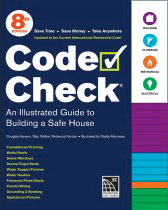Podcast 267: Duct Sealing, Patching Brick, and Transitioning from Landscaper to Builder
Matt, Kiley, and Patrick hear from listeners about knowing the code and changing careers before taking questions on sealing ductwork, canceling a brick opening, and fixing wonky stairs.
Follow the Fine Homebuilding Podcast on your favorite app. Subscribe now and don’t miss an episode:
 |
 |
Ed reminds the team about Code Check. Rick describes his hand tool setup for basic home repair. Carol asks Dejah Leger about becoming a carpenter. Mason writes in with information you don’t want to know. Kevin is looking for a way to seal his ductwork. Nick wants to know how to patch a brick opening. Robert asks for help leveling his stair treads and a pair of nameless landscapers want tips on becoming home remodelers.
Editor Updates:
Matt’s gazebo, mud room
Kiley’s Kitchens & Baths
Jeff’s Windows
Patrick’s Liam’s home labor
Listener Feedback 1:
Ed writes: In FHB Podcast 263, Austin asks about what he can do to know about code requirements. Taunton (you may have heard of them) publishes Code Check books.
These guides are useful for knowing what needs to happen at the micro- and macro level of work – electrical, plumbing, etc. They are easy to use, but they are not really geared for DIYers. They help DIYers in determining a gap of knowledge. This should encourage the DIYer to find an additional more detailed resource.
You should really encourage DIYers to get an unlimited subscription to FHB. It is well worth the cost. Mistakes in home renovation are costly. The articles and videos available through the unlimited subscription are very helpful curated content. The value of the curation can be measured in the amount of time you spend on YouTube watching videos that aren’t good or even safe info.
Keep up the great podcast. You should have Kiley host once in a while. Keep craft alive!
Related Links:
Listener Feedback 2:
Rick writes: Kiley, Patrick, Matt, and Whomever Else You Rope In, In the last podcast, a listener wanted to know about amateur vs. pro tool selection and bag secrets.
I was a serious DIYer and then spent a year as a handyman, and yes, a few nuances did surface with the transition. As mentioned on the ‘cast, plumbing, electrical, masonry, etc kits are very useful, but the evolution for me was to keep the right mix in my always carry bag, which made a huge efficiency
difference.
After about five attempts, I settled on 25# of you in an over the shoulder cloth/plastic/leather tool bag to save customers’ surfaces. Surprisingly, Husky was the winner. I kept the things in there you would imagine, like pliers, 8″ crescent, pencil, etc. but the tools below may be instructive to DIYers.
- 6 in 1 screwdriver, not the all in wonder kludges.
- A 2″ deck screw can solve many problems in a pinch,
- but a carefully curated set of fasteners in the bag makes jobs go quickly.
- 6×32 electrical screws, switch plate screws, long strike plate screws, wall dogs,
- drywall coarse thread screws, wire nuts, etc.
- An eggbeater drill plus drill bits for weight, since I’m normally only drilling 3 holes.
- A sharp, foldable fine pullsaw, as well as a drywall saw.
- A circuit transmitter and receiver, as well as a pen-sized voltage detector.
- A roll of blue tape.
- 20′ of 3mm cord
- A telescopic magnet, like you’re working on a car can save a 30 min store run.
- A small LED based flashlight.
- A small laser measure.
Work mix drives much of this, but most short jobs required my standard bag plus one kit. As far as brands, you generally get what you pay for. Buy once, cry once.
Keep your attic sealed!
Related Links:
Listener Feedback 3:
Carol from Sierra foothills writes: Hello, I thoroughly enjoyed the podcast with Dejah Leger! It is encouraging to see more women entering the trades and excelling at them. My question to her or other women in the trades is how did you go about entering the workforce, and where did you train, study, etc. in order to do so? I have always enjoyed working with my hands, making things, creating art, etc. and have often thought about what it would be like if I had been introduced to carpentry at a younger age. (I grew up the old school way, in which girls were taught home ec and boys were taught wood-shop and auto repair.) I also have a background in graphic design and fine art and am very drawn to carpentry and other aspects of building, however, where I live (Sierra foothills) there are very few, if any, resources nearby for hands on learning. I have learned a lot from working on my own house, reading, and watching videos, but I want to make sure I learn the right way to do things and have come to realize that absolutely nothing goes the way it does in a book or video. There are always problems that pop up that throw the proverbial wrench in my well laid plans. Any advice would be greatly appreciated! Thank you!
Dejah responds:
That’s awesome, thanks Carol!! It sounds like you’d be a really good fit in carpentry. I really do believe it takes an artistic eye and that it is a creative craft.
I’m 39, and only got into this trade at 37, so as much as I wish I had discovered carpentry sooner, there’s no reason either to not pursue it as a career at any age. I was very lucky to be trained directly on the job by the other two lead carpenters I work with. I shadowed them both for a year and learned on-site. I continued my own education on my own time with videos, books, articles (subscribe to Fine Home Building and JLC magazines for sure).
The company I work for is not union, and that’s an important distinction. If you’re going with a union job, an apprenticeship program is a set amount of years and training. You come out of the apprenticeship a very good carpenter and move into a journeyman role. Unions, at least here in Seattle, tend to work more of the new construction jobs. The pay scale is transparent and set by the union.
Working for the private sector, I was able to accelerate at my own pace and take on lead roles sooner, but the pay scale is all over the place and there’s less formal training (if any). But there’s also more freedom in controlling my own work sites and establishing deep relationships with the other trades we contract with, as well as with my work crew.
Either way, the best advice I can give is to leap in and go for it. Remember that many, many men apply for jobs they have no qualifications for and don’t even care. Don’t get hung up on experience or how you’re going to learn, just be honest about your background and be open to learning. We women are trained mentally & culturally to want to over-qualify and over-achieve and sometimes let those expectations of ourselves get in our own way. Joining a “boys club” is intimidating, but I’ve had nothing but positive experiences and formed great friendships, and I hope if you become a carpenter that you will have the same accepting experience.
Please feel free to keep in touch and let me know how your journey goes!!! Go for it!!!
Dejah Léger, CAPS
Related Links:
- Keep Craft Alive: Maria Klemperer-Johnson, Builder and Instructor
- Resistance to Change and Other Challenges in Construction
Listener Feedback 4:
Mason of Hudson Valley Preservation writes: Good morning, Kiley, people often ask if we find anything of value in old house walls. Like a hidden cache of cash. In almost 40 years of renovating I’ve never found anything that could be exchanged for a profit. We have found cool pottery, assorted kid’s toys and even a letter from the builder of a house in 1845 titled “To Future Generations”.
We’ve also found a lot of dirt and disgusting. Fiberglass insulation riddled with mouse tunnels and all they leave behind, carcasses, piss, and shit. The attached photos show a phenomenon first encountered on the 1780-house you have expressed interest in writing about.
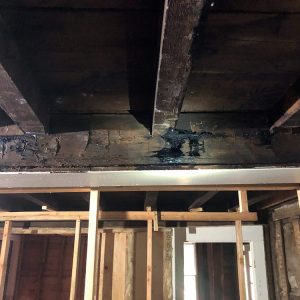 |
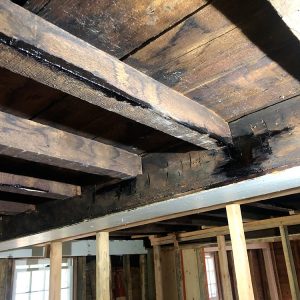 |
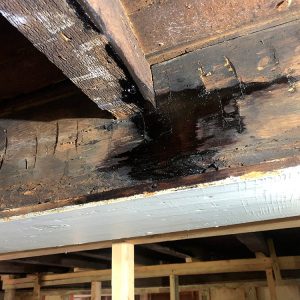 |
 |
The Mouse-Poop photo shows a pile, up against a beam. Nothing too unusual, however what happens next raises the grossness level to new heights. We noticed staining on the floorboards below. The poop had liquified and penetrated the adjacent wood and dripped down. We have cleaned the area and the next day, it continues to ooze! I don’t think I need to mention that it stinks, but you can smell the smell outside of the house.
My take-away? Have you ever been in a house and there is a mystery brown stain on the ceiling? The questions are-Is the roof leaking? Is there mold? I have often speculated that it could be rodent activity, and now I have proof. Ha!
We’ll clean it and spray it again today with a microbial solution and hope we can stop the ooze.
Related Links:
Question 1: I’m looking to seal ductwork in my house. Is Aeroseal worth the extra cash or should I lean towards the cheaper solution?
Kevin Des Moines, IA writes, Hello Fine Homebuilding! I am in the process of researching the best way to seal my ductwork throughout my house. We live in Iowa, where the winters are very cold and the summers, especially right now, are hot and quite humid. Our house was built in the 1930s and is two stories, so the second story is quite warmer during the summer than the rest of the house. In my research, I stumbled on the Aeroseal product that seals any leaks and penetrations in your ductwork from the inside. The other option would be to manually seal the exposed ductwork with mastic and tape. This option is significantly cheaper, but you’re limited to only the ductwork that you can reach.
I looked through the GBA forums regarding Aeroseal and actually found Patrick’s question from back in 2014. The reaction in most of the forums seem to be pretty mixed, with a lot of people not able to justify the high price tag. Since we are looking for more of a comfort solution, as well as a slight payback from energy savings, it is harder to figure out how much I’m willing to spend on the Aeroseal product.
Patrick, can you elaborate on what you learned back in 2014 about Aeroseal, and have you learned of any updates since then? I think I’m leaning towards the DIY mastic and tape solution at this point.
Thanks!
Related links:
Question 2: What is the best way to build a brick patch?
Nick from Fort Wayne writes, Hey guys, my dad plans to remodel his bathroom and I volunteered to help. The window pictured is in the shower and he plans to get rid of it for obvious reasons. Due to an unfortunate parking job, we have found a stash of matching brick to patch where the window would be. I have no experience with brick laying but I think I could figure it out. My question is: What would be the best way to build a patch? Thanks guys, I love the show.
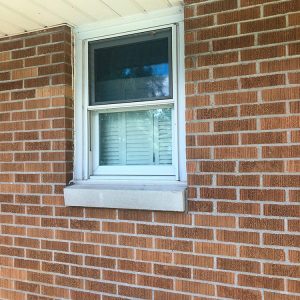 |
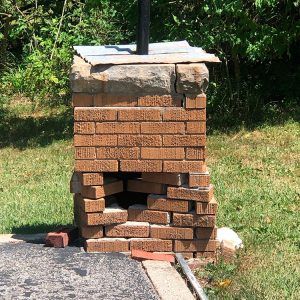 |
Related links:
- Take the Fear out of Brick Veneer
- Why Are There Dry Joints in My Brick Walls?
- Moving an Opening in a Brick Wall
Question 3: How can I fix stringers that came out of level?
Robert from Baden, Ontario, Canada writes, I’m finally writing in to my favorite podcast (outside my own called ‘Dingers‘ which is about fantasy baseball) and doing it because I’m 98% finished my addition. You ship stickers to Canada right!?
— 98% doesn’t include interior or exterior trim, basement drywall, parging my stone foundation that’s now an interior wall, the yet to be constructed deck, the driveway, the section of gate that’s going to be converted to a fence or moving the hydro from the air into the ground and at the same time put in drainage that I wanted to be the focus of my email today, but I’ll go for the 2% that’s left to get occupancy!
— So, the 2% is the stairs that have a slight downward slope & the spacing between my spindles, sounds simple right? Well, I have 160 spindles, every other spindle is secured with an anchor (see photos).
 |
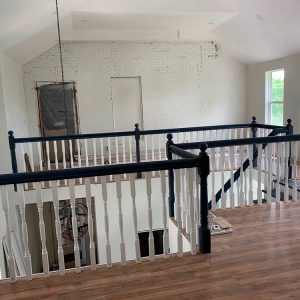 |
 |
 |
— The steps (that I build myself!) seem like the simple fix and possibly this will be completed before you’re able to help me, but I put Lumber lock on each stringer and used finishing nails to hold them in place and did not step on anything for a day. What happened to get them out of level was… the Lumber lock wasn’t squished down enough with the finishing nails and created a slope on roughly 23 of my 30+steps, awesome. I think the fix is simple, I pop the stairs loose and use the riser or shims to level the step and re-secure with Lumber lock but this time I use a proper nail or screw down each stair so nothing stays out of level. Sound good? What’s better? Rookie mistake, right? Like my proposed fix?
To the spindles… max allowance is 4” at any point, (I’ve done everything on this addition outside of setting the concrete forms, most framing, rough in electrical, HVAC & plumbing) so I measured the base which is flat & ensures no gap exceeded 4”. Well we had these matched to our original staircase and these 1905 spindles that dip in 1/2” in spots so the gaps are now as much as 5” apart. Most will need to be moved.
I have laminate floors and my question/wife’s concern is how can I minimize the damage to the floors and elsewhere since most of these will be moved and some 1/4” holes will be exposed?
I have a hundred other questions but those 2 are what I’ll be doing this week in order to get occupancy to the addition.
Can’t stress how much I enjoy the podcast. I’m a chef by trade but contractor wannabe and this podcast scratches that itch along with both fine Homebuilding & fine woodworking. My Instagram account is questionable contracting because that’s what my wife calls my work. I’m 37 so I’m calling myself young and on the rise!
Appreciate any help!
Related links:
Question 4: What are some good resources on building your own remodeling business?
Name withheld by request writes, Hello FHB podcast crew! I have recently discovered your podcast and have enjoyed it a lot so figured I would throw a question out for you guys that probably isn’t podcast worthy, but wondering if you guys might have some words of wisdom on it since you’re all very knowledgeable in the entire home building/remodeling fields.
Long story short my brother and I have been in the high-end custom landscape installation business for about 35 years between the two of us, and when I say landscaping I mean paver/stone driveways, modular and natural stone retaining walls, softscapes, as well as more production style townhouse install work. So, we have management skills for running a job sites and have general building knowledge being that we run the crews as well as install with the crew members.
We are both ready to leave the landscaping industry and have decided we would like to be our own bosses and start a remodeling business. Now our uncle has a remodeling business and has promised to show us and teach us as much as he can in the next year or 2 before he retires and the landscape business is our family’s business so we both have a little experience in the basics of running and business, bidding and book work.
Are you aware of or is there any programs (online preferably) you would recommend that we can take to expedite the learning curve on home remodeling in general? Again, my uncle is going to teach us hands on, but it would be great to get some formal education on the industry as well.
Appreciate any information you guys might be able to send my way.
Thanks in advance and keep up the awesome podcast I’m learning just by listening to you guys!
Related links:
 End Note:
End Note:

Joe from Des Plaines, IL NW of Chicago writes: Hello fine insulating podcast. I found this fun article in the Popular Science archives that I thought you might like. It discusses the “new” Arkansas standards in insulation. 12 inches of attic insulation… Are they mad? It’s an interesting article right at the start of energy efficiency programs.
The issue also includes articles on heat pumps: the new way to heat AND cool.
The insulation article starts on page 130 in the Sep 1976 Popular Science.
I hope this is interesting,
I remember reading this magazine. I was a weird 11 year old.
If you have any questions you would like us to dig into for a future show, shoot an email our way: [email protected].
If we use your question we’ll send you a FHB Podcast sticker!
FHB Podcast T-shirts!
Represent your favorite podcast! Available in several styles and colors. Made from 100% cotton. Find the Podcast t-shirt and more cool products in the Fine Homebuilding Store.
This episode of the Fine Homebuilding podcast is brought to you by Feeney.
Today’s episode of the Fine Homebuilding podcast is brought to you by Feeney®. Who knew extremely durable top rails could look this good? DesignRail® from Feeney makes it easy for you to bring your vision to life with its wood grain powder-coated top rail finish that provides an extra layer of durability, coupled with the beautiful look of wood. But don’t take our word for it, discover how Feeney can elevate any project with a Cherry, Walnut or Weathered Gray wood grain top rail.
Feeney Makes it Easy. Visit FeeneyMakesItEasy.com to learn more and find your nearest Feeney dealer.
Fine Homebuilding podcast listeners can now get 20% off anything in the Taunton store, including the The Visual Handbook of Building and Remodeling, 4th Edition.
Use the discount code FHBPODCAST to take advantage of this special offer.
We hope you will take advantage of a great offer for our podcast listeners: A special 20% off the discounted rate to subscribe to the Fine Homebuilding print magazine. That link goes to finehomebuilding.com/podoffer.
The show is driven by our listeners, so please subscribe and rate us on iTunes or Google Play, and if you have any questions you would like us to dig into for a future show, shoot an email our way: [email protected]. Also, be sure to follow Justin Fink and Fine Homebuilding on Instagram, and “like” the magazine on Facebook. Note that you can watch the show above, or on YouTube at the Fine Homebuilding YouTube Channel.
The Fine Homebuilding Podcast embodies Fine Homebuilding magazine’s commitment to the preservation of craftsmanship and the advancement of home performance in residential construction. The show is an informal but vigorous conversation about the techniques and principles that allow listeners to master their design and building challenges.
Other related links
-
- All FHB podcast show notes: FineHomebuilding.com/podcast.
- #KeepCraftAlive T-shirts and hats support scholarships for building trades students. So order some gear at KeepCraftAlive.org.
- The direct link to the online store is here.
